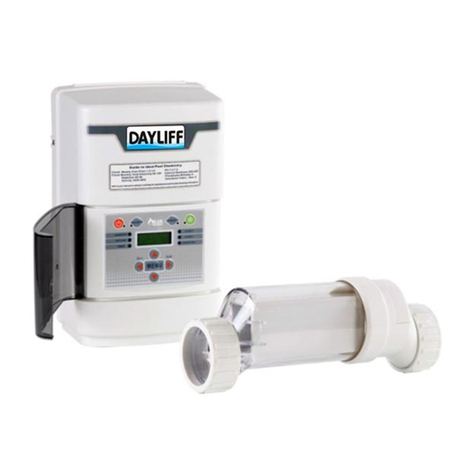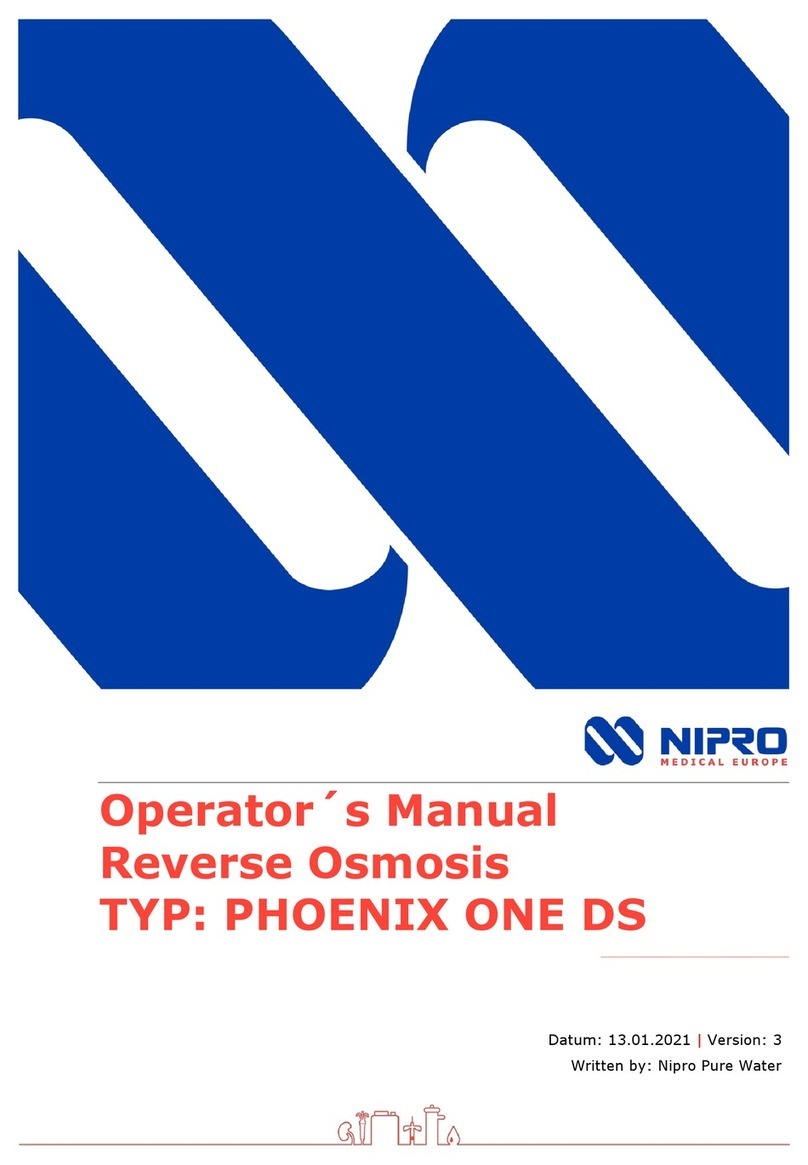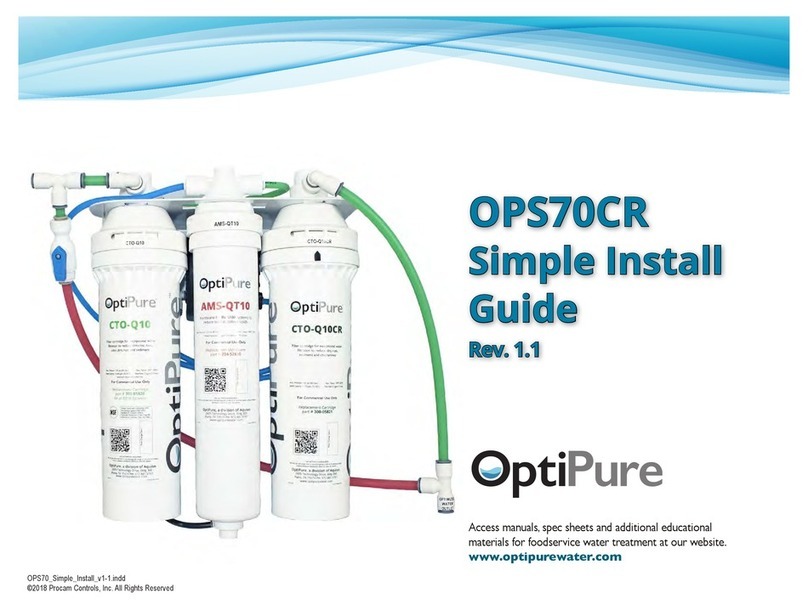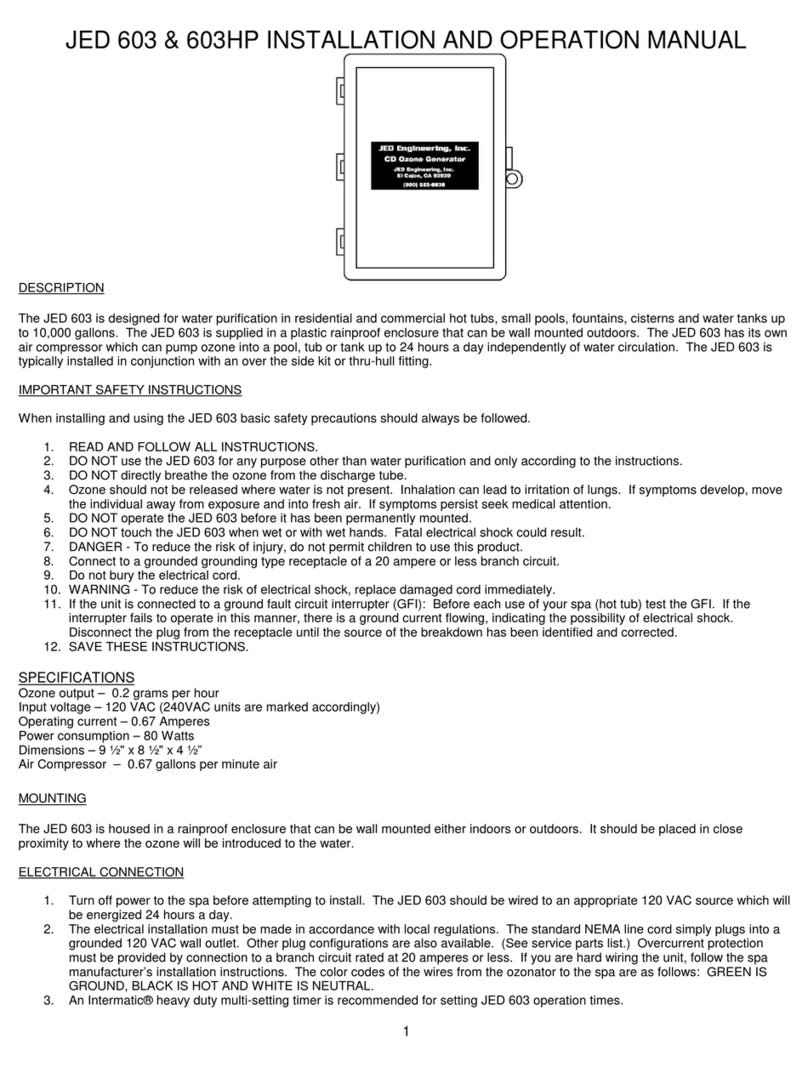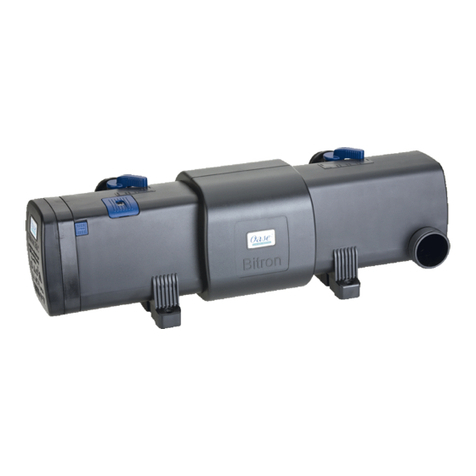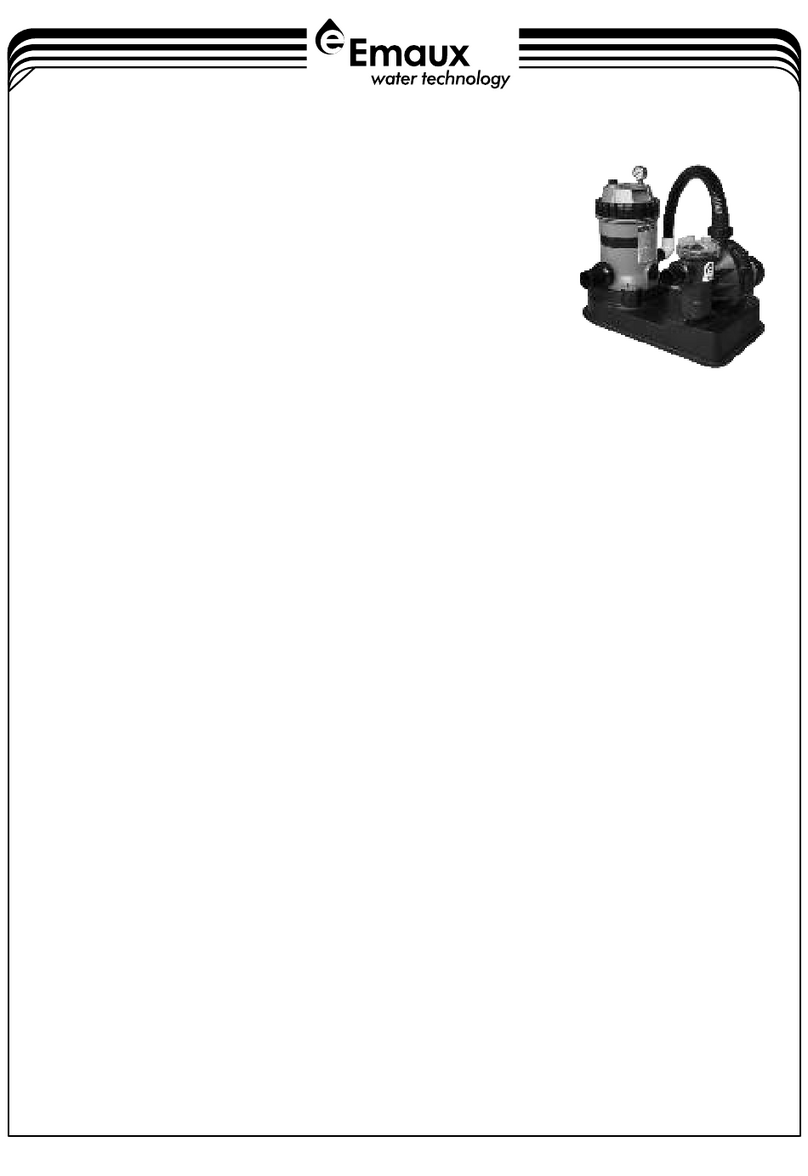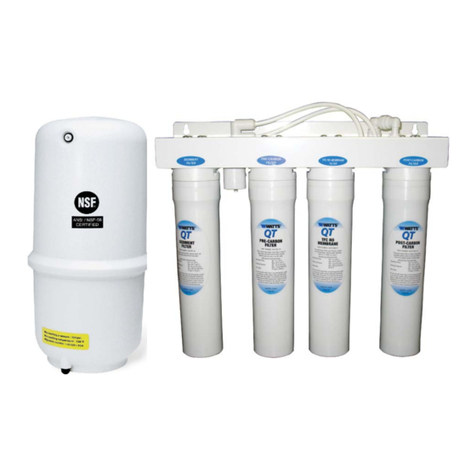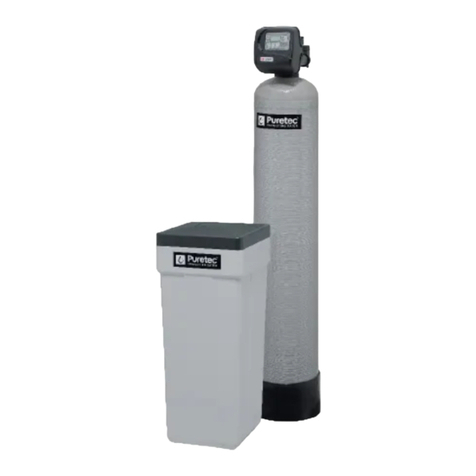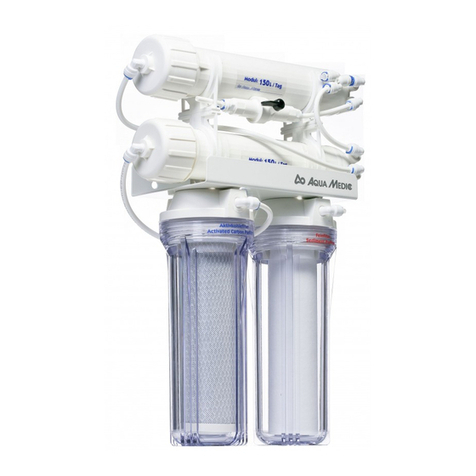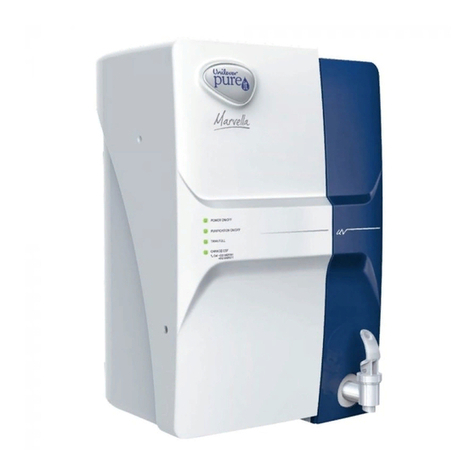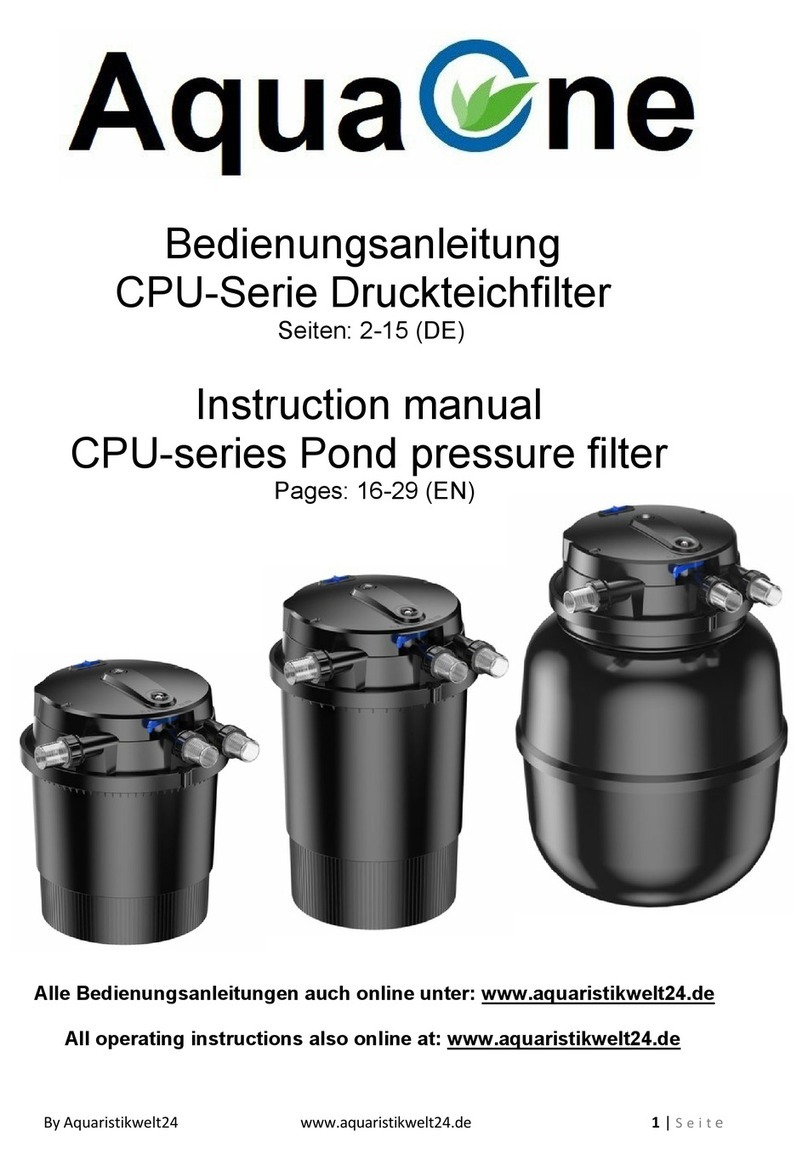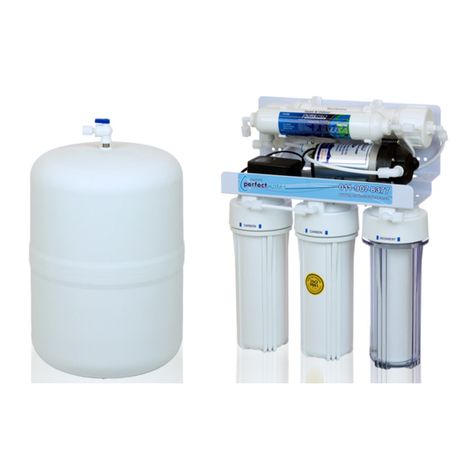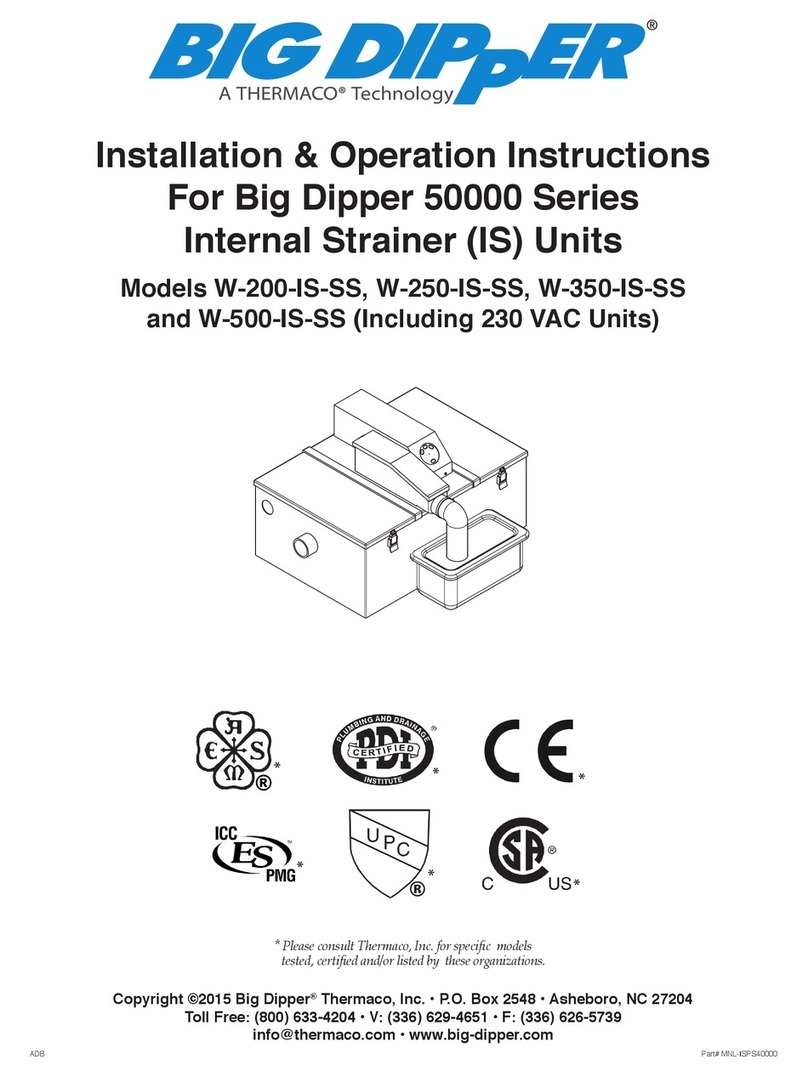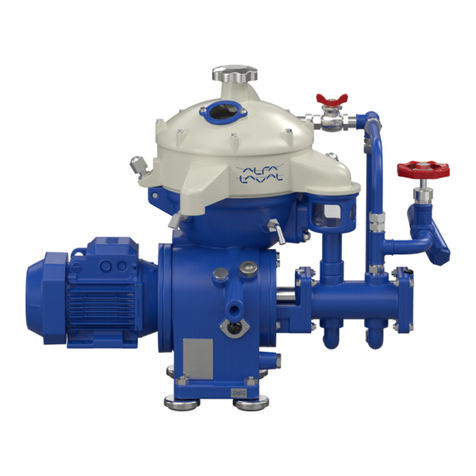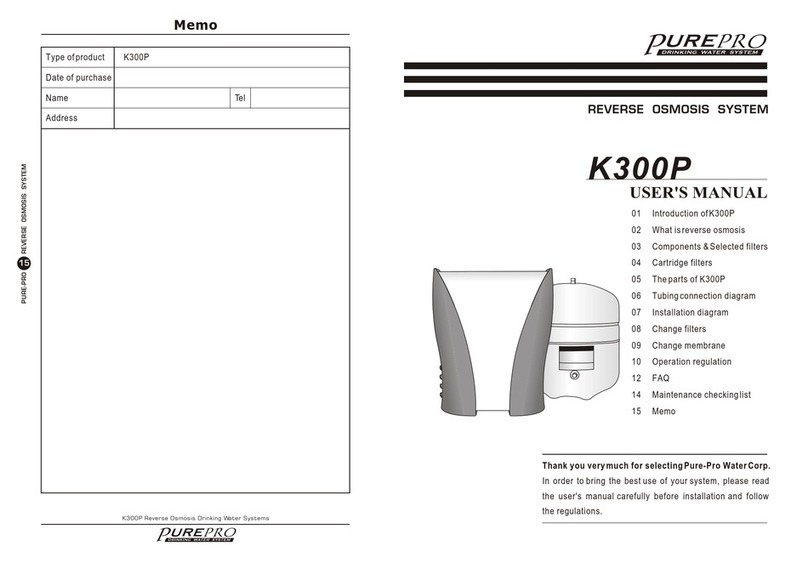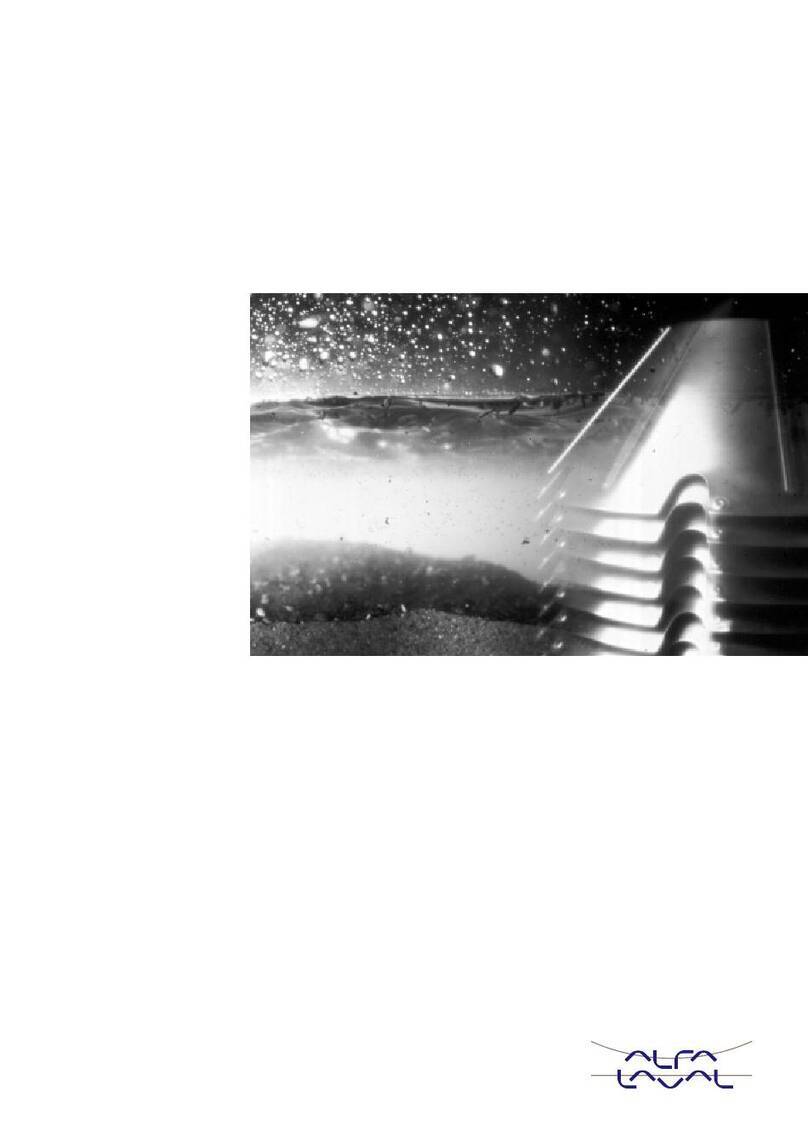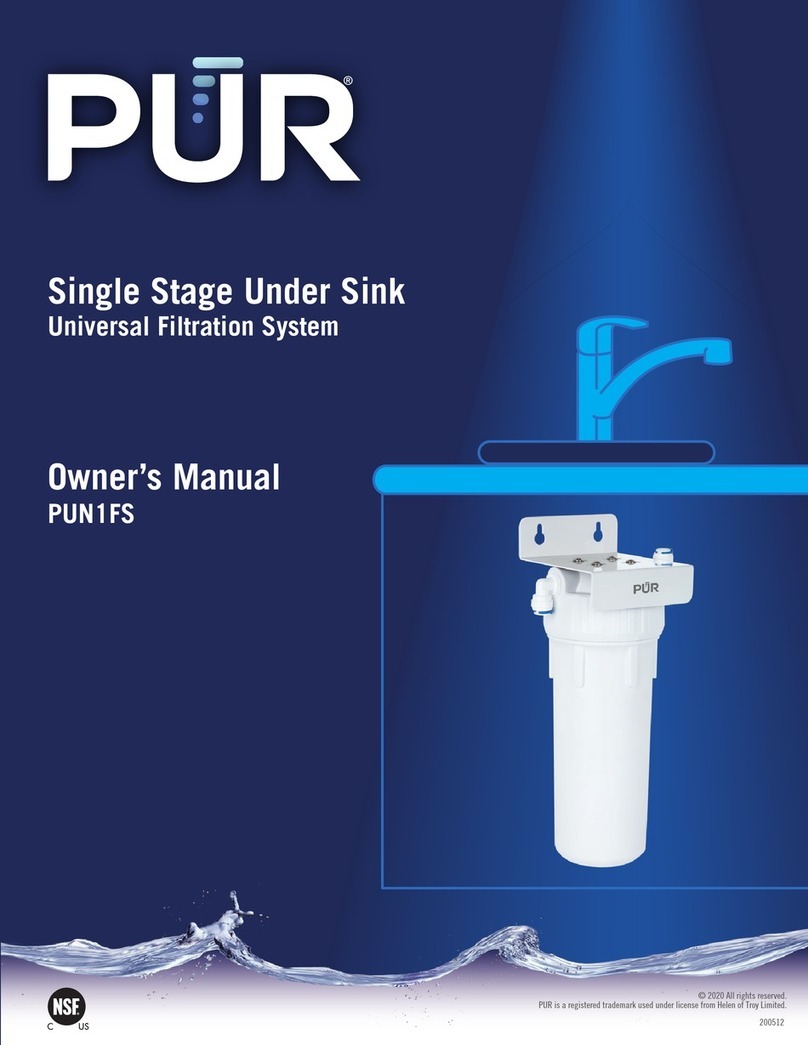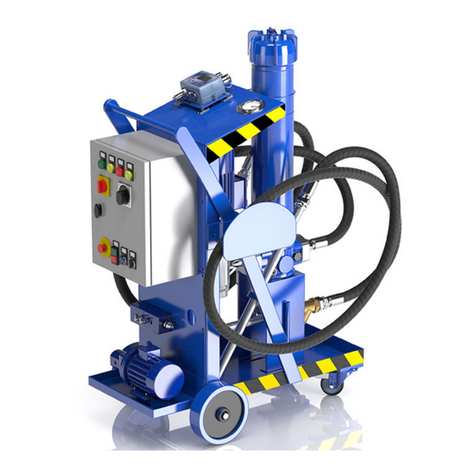DAYLIFF BUF 4 Installation instructions

Installation &
Operating Manual
BUF 4
Ultrafiltration Treatment Plant


SPECIFICATIONS
1.
1
2.
INSTALLATION 4
INDEX
© Davis & Shirtliff Ltd 2022
Contents herein are not warranted
4. MAINTENANCE 9
2.1 Equipment Specication 4
2.2 Module Description 4
3.
OPERATION 5
3.1 Pre Treatment 5
3.2 Filtration & Flushing Process 5
3.3 Start Up & Start Up Pre Checks 8
3.4 Module Flushing 8
3.5 Shutdown 8
4.1 CIP 9
4.2 Fouling 10
4.3 Handling & Storage Procedure for UF Membranes
10
5. TROUBLE SHOOTING 11
6. TERMS OF WARRANTY 14

1
1. SPECIFICATIONS
DAYLIFF BUF4 Ultrafiltration plants are highly effective, easy to operate and simple to
maintain systems that offer the ideal solution for small and medium scale water treatment
requirements. Their particular application is for the removal of particles, colloidal
material, sand, organic and inorganic polymeric particles. They are particularly suitable
for the treatment of polluted surface waters from dams, rivers, reservoirs etc. as well as
wastewater recovery. The process will not remove dissolved salts including sodium,
calcium and chlorides and so is not suited to the treatment of groundwater with high TDS
levels. Standard models are suitable for low turbidity (up to 15NTU) raw water
applications.
Systems are frame mounted and supplied as complete units with all necessary accessories
and controls for simple integration with the flow process.
Congratulations on selecting a BUF4 Ultraltration Treatment Plant.
They are manufactured to the highest standards and if installed and
operated correctly will give many years of efcient and trouble free
service. Careful reading of this Installation Manual is therefore
important, though should there be any queries they should be
referred to the equipment supplier.
Filtrate
B/Wash CIP
Tank 100LT
Pump
controller
120 Microns
Strainer
Flush Valve
Raw
Water Inlet Valve
Dayliff UF Membrane
Drain
Drain
Valve
PI
PI

2
They offer the following features:-
• Fully automated plant operation including normal filtration and backwash cycle
with solenoid valve activation.
• High efficiency single Dayliff feed/backwash/cleaning pump with integral Brio
pump controller for auto switching and dry run protection.
• 120-micron pre-filter.
• Integrated CIP/Cleaning/Backwash/Flushing tank.
• System monitoring instruments including product flow meter and pressure gauges.
• Skid mounted for simple installation.
DAYLIFF BUF4 systems provide a high performance, high efficiency treatment process that
produces fully potable water without chemical additions. The process uses low energy
consumption and provides consistent quality without frequent operational intervention.
Due to the efficiency of the membranes, it also offers considerable savings over
conventional systems and is the ideal solution where potable water is required.
OPERATING PARAMETERS
Operating Pressure: 0.2 - 2bar
Maximum Feed Pressure: 3 Bar
Maximum Operating Trans Membrane Pressure (TMP): 2 Bar
Chlorine Tolerance: 100 ppm
0
Max Operating Temp: 45 C
Operating pH Range: 2-12
Raw Water Quality: Turbidity <15 NTU, Oil/Grease 0 mg/l
Treated Water Quality: <0.2μm
Recovery Range: 95-98% depending on raw water quality.
Backwash Frequency: Every 20-60mins
A raw water analysis should be provided to establish the extent of pre-treatment
necessary.
EQUIPMENT SPECIFICATIONS
BUF4/140BUF4/70BUF4/40
3
Flow Rate(m /hr)
No. Membrane Modules
Pump
0.35
80
0.25
1
DDP50A
1200x1100x1700
0.7
90
2
1.0
100
1.4
110
0.37 0.75
3 4
DDP60 DDP65
Dimensions (LxWxH)mm
Weight, Kg
kW
Type
BUF4/100

3
Ultrafiltration (UF) involves pressure-driven separation of materials from a feed solution.
The technology is used to remove particulate and microbial contaminants, but it does not
remove ions and small molecules. Pressure drives the process, which typically operates
with a feed pressure of 0.2 to 2bar. UF plants are automated and have low operational
labor requirements. These systems, however, can require frequent cleaning. UF
membranes are commercially available in tubular, hollow-fiber, and spiral wound
configurations.
UF membranes reject solutes ranging in size from 0.2 microns and larger. The UF
membrane process separates molecules within the solution on the basis of size. The pore
size and molecular weight cut-off (MWCO) are often used to characterize a membrane.
The pore size is the nominal diameter of the openings or micro-pores in the membrane
expressed in microns. BUF4 membranes have a 100K pore size.
Different membrane materials with the same nominal MWCO may have differing particle
rejection. Pore size distribution and uniformity rather than the chemical nature of the
membrane material may cause this effect.
1.1 Working Principle
Fig 1: Material Size and Membrane Filtration Process Guide
Metal Ions
Insecticides
Micrometers (log scale)
Human Hair
0.0001 0.001
1
0.01
100
0.1 1.0 10 100
Micrometers (log scale)
Approximate Molecular Weight (Daltons)
200 1,000 10,000 20,000 100,000 500,000
Angstrom Units (Log Scale)
10
2
100 1000 10' 10' 10'
Separation Processes
Reverse Osmosis
IX Nanoltration
DOW Electrodeionization DOW Ultraltration
Microltration
3 6 8 2 3 6 8 2 3 6 8
20
30
60
80
200
300
600
800
2000
3000
6000
8000
Ionic Range Molecular Range Macro Molecular Range Micro Particular Range MacroParticular Range
Latex Emulsions
Endotoxins Pyrogens
Soluble Salts
Antibiotics
Dissolved Organics
Crypto
Bacteria
Colloids
Algae
Viruses
Relative Size of Common Materials
Glardia

4
2. INSTALLATION
2.1 Equipment Specication
The Ultrafiltration plant consists of the following major components
1. Feed pump/Backwash/CIP pump.
2. Electric Solenoid valves -Inlet, Flush and Drain valves.
3. Backwash/CIP tank.
4. Pump controller.
5. Timer circuit.
6. UF membrane.
7. Piping.
8. Optional Waste water tank.
9. Optional Raw water tank.
10. Optional chemical dosing tanks.
11. Optional chemical dosing systems.
2.2 Module Description
Systems are frame mounted and supplied as complete units with all necessary accessories
and controls for simple integration with the flow process. They offer the following
features:-
ŸFully automated plant operation including normal filtration and flushing cycle.
ŸHigh efficiency single Dayliff feed/backwash/Cleaning pump saving energy, i.e.
Low CAPEX and OPEX.
ŸIntegrated automated backwash/flushing/cleaning process.
ŸSystem monitoring instruments including product flow meter and pressure gauges.
Ÿ120-micron pre-filter.
ŸSkid mounted for simple installation.
ŸIntegrated CIP/Cleaning/Backwash/Flushing tank.
ŸDry running pump protection
Fig 2: UF Membrane Cross Section
1. Feed water enters chamber on offset
2. Floods hollow fibres internally
3. Breaks through walls
4. Exits through middle (center tub) pipe
5. Flows through center fitting
6. Electric valve flush valve opened to strip build up inside each hollow fibre
1
2
34
5
6
Centre tube
with holes in
Clamp
Clamp
Seal
Product
(Clean)
Flush
End Cap
End Cap
Raw
Feed
Hollow Fibre
Magnied

5
3. OPERATION
3.1 Pre Treatment
Ultrafiltration membrane designs are based on qualified feed water conditions as shown
in table above. If the feed water quality is outside of the required levels, a pilot study should
be done to confirm performance, increase the number of UF membranes to lower
filtration flux or pretreatment must be considered.
Depending on application, a safety screen of 150 – 300 microns is recommended on the
feed to the UF system, which must be frequently cleaned at least once a day depending on
If the system is designed and installed to the conditions shown
but the feed water quality is not maintained as required, then
consult a Dayliff retailer.
WARNING
Depending on application, a safety screen of 120 microns is recommended on the feed to
the UF system, which must be frequently cleaned at least once a day depending on the
quality of water. A variety of technologies can be used such as self-cleaning screens and
bag, cartridge, or disc filters. Depending on the type of water or range of feed water
parameters other pretreatment technologies such as oxidation, coagulation, and
sedimentation and media filtration may also be recommended.
3.2 Filtration & Flushing Process
Fig 3: Filtration Step for UF membrane
Solenoid
Inlet
Valve Feed
Pump
Controller
Solenoid
Inlet
Valve
Solenoid
Flush
Valve
B/Wash
CIP
Tank
100LT
Drain
120 Microns
Strainder
FILTRATE
Solenoid
Drain
Valve
To Drain
Dayliff UF Membrane
Filtration
ŸInlet solenoid valves open|flush solenoid valve closed|Drain
solenoid valve closed
ŸSettable timer settings - 30min*
ŸFlush tank filling until full
ŸMonitor differential pressure (feed pressure filtrate pressure
should never be more than 2Bar
ŸRegular cleaning of feed line screen filter every week or
sooner

6
Normal operation refers to the routine operating sequence of a system and includes the
filtration and flushing steps. At initial startup, the UF membranes are flushed for 3hrs to
remove any residual chemicals.
•This is done by manually adjusting the timer box settings to extend flushing time. The
flush process does not make filtrate.
•After the start up forward flush is done, the UF membrane can be placed in the
filtration mode by manually adjusting the timer settings.
•A filtration cycle ranges from 6 to 30 minutes and while in operation, all the feed
water is converted into a filtrate. As contaminants are removed during the filtration
mode, the trans-membrane pressure (TMP) increases (difference in pressure
between the feed and the filtrate line).
•At the end of the set filtration cycle time, a flushing (cleaning) sequence will be
triggered automatically for the flush duration set and the process is routine and
repetitive during normal operation.
Fig 4: UF Membrane Flushing
Flushing
ŸInlet solenoid valves closed| Flush Solenoid Valve
Open | Drain solenoid valve open
ŸSettable timer settings - 30 Secs*
ŸFlush tank filtrate water level falling
Pump
Controller
To Drain
Solenoid
Inlet
Valve Feed 120 Microns
Strainder
Solenoid
Flush
Valve
Flush
CIP
Tank
100LT
Drain
Solenoid
Drain
Valve
FILTRATE
Dayliff UF Membrane

7
•The flushing mode occurs automatically (after manually setting the timer) and is
used to loosen and wash-out particulates deposited on the hollow fiber of the UF
membrane.
•It's critical that the flushing time be set long enough to wash-out all dirt until clear
water is observed.
•The flush time may therefore vary depending on the water quality. Typically, 30sec is
set as standard flush time but should be changed at site appropriately.
Fig 5: BUF4 CIP Process
CIP
ŸInlet solenoid valves closed| Flush Solenoid Valve
Open | Drain solenoid valve open
ŸSettable timer settings - 60min* until no pH change
ŸCIP tank chemical recirculating
Pump
Controller
To Drain
Solenoid
Inlet
Valve
Feed 120 Microns
Strainder
Solenoid
Flush
Valve
Flush
CIP
Tank
100LT
Drain
Solenoid
Drain
Valve
FILTRATE
Dayliff UF Membrane
The Clean in Place (CIP) is performed by circulating CIP chemicals until UF membrane
recovers operating flow and pressure.
•During the CIP process recirculation of the chemical is done until there is no further
change in the pH of the CIP chemicals which indicate no further chemical reaction is
ongoing.
•A soak operation can also be included to improve the effectiveness of the cleaning.
•Soaking for 1-2hrs allows more time for the chemical to react with contaminants that
have attached to the membrane surface or penetrated the fiber wall. To soak, once
the unit is circulating the CIP chemical, power off the unit and close off all ball valves
to ensure CIP chemical stays within the UF membranes for the soak period. After the
soak a routine flushing is performed to remove any remaining particulates and
residual chemicals.

8
3.3 Start Up and Start-up pre-checks
Once the UF membranes supplied loose along with the equipment are installed inside the
housing that carry the membranes, the following procedures should be followed for the
start-up of Ultrafiltration unit. Manually start the equipment during initial operation. Flush
the UF unit to remove the particles, debri and preservative storage solution before
operating the equipment. Target a filtrate flow of 60% of design during initial operations.
After 24 hours, the filtrate flow can be adjusted to design conditions. Check all valves have
been opened or closed appropriately and both raw water and storage tanks are
connected.
Start the equipment by following the steps below:
1. Plant power source should be powered through an Automatic Voltage Switch (AVS).
2. Confirm timer settings okay (Filtration 30mins /Flushing 30sec).
3. Connect the loose CIP/Flush tank to the inlet and clean water lines of the UF unit.
4. Start the feed pump by switch ON the power socket.
5. Confirm the flushing operation is draining waste water from the unit.
6. Once flushing is complete, confirm filtration time is properly set.
7. Record the feed pressure and the filtrate pressure from the pressure gauges.
8. Confirm proper operation of float valve in the Flush/CIP tank.
9. Confirm filtrate water quality is okay.
10. Confirm dry running protection by closing and opening the raw water source.
3.4 Module Flushing
The Ultrafiltration membranes should be rinsed prior to startup to remove preservative
fluid shipped in the UF membranes. Flushing should be performed until no foam is
observed in the wash water. Depending on the treatment application, additional rinsing or
disposal of the filtrate may be required.
3.5 Shut Down
•To conduct a manual shut down the power socket should be turned off. It's however
important to perform a flushing operation before shutting down the unit especially
where the unit will be off for extended periods of time.
•If the equipment is down for more than two days, potential buildup of particulates
and colloidal matter on the surface of the membranes is highly prevalent. High
transmembrane pressure (TMP) indicates clogging and presence of contaminants
on the surface of the UF membranes. 60 minutes of UF operation per day can
protect the equipment from bacterial fouling. If the equipment is down for more than
seven days, add a storage solution i.e. preservative (1% NaHSO3), and close all
valves to ensure preservative is stored within the UF membrane. During the long-
term storage, pH should be checked monthly. Replace the storage solution if the pH
is above 3. During shut down, the UF membrane should always keep moist.

9
4. MAINTENANCE
The key to getting good service from a UF module is maintenance. The main maintenance
procedure required is cleaning/flushing. The flushing cycle is automated to ensure it's not
forgotten or skipped which can be detrimental to the life of the UF membrane. The
filtration cycle (about 30mins) will automatically alternate with the flushing operation that
removes particulates from the UF membrane.
4.1 CIP
A clean in place (CIP) operation includes flushing operation and chemical recycle to clean
the UF membrane. The CIP is an on demand operation. The frequency of CIP is dependent
on the feed water quality but can range from 1 to 5 months. Prior to a CIP operation, the
routine flushing operation is performed. After completing the flushing operation, CIP
chemicals are recycled/re-circulated from the CIP chemical tank to UF membrane while
monitoring the pH until there is no change in pH.
The process operating parameters for the cleaning steps are provided in table below.
Summary of Cleaning Process
Flushing Frequency Once every 20 to 60 minutes (water source
or pilot test reaults)
Flushing Duration 30 to 120 seconds
2
150 to 250 Lm h
When TMP* exceeds 1.0 bar above starting
/ initioal TMP* (at same temperature)
120 minutes (recycle and soak) or longer
(until no change in pH)
Check with Dayliff retailer for approved
chemicals
2
50L/m h
0
5-45 C
Flushing Flux
Clean in
Place
Frequency
Duration
Cleaning Solutions
Cleaning Flux per
Module
Temperature Range
An Alkali CIP chemical is first used followed by an acid CIP chemical. During the CIP
operation, the flushing timer setting are adjusted to say 2hours to allow use of the Flushing
tanks as the CIP tank using the feed pump. A small chemical filtrate stream will also be
collected and must be recycled to the chemical cleaning tank. Note that the CIP solution
can be heated up to 40ºC to improve its effectiveness at removing contaminants from the
UF membrane.
**TMP =Trans-Membrane Pressure (filtrate pressure minus feed pressure)

10
4.2 Fouling
There are four types of fouling common to UF operations including particulate, biological,
inorganic, and organic.
Particulate fouling is caused by suspended solids, colloids, and turbidity that can be
reduced by coagulation, sedimentation, clarification, and media filtration. The common
cleaning method for particulate fouling is air scour and backwash.
Biological fouling is caused by the growth of microorganisms that can be reduced by
using in-line chemical feed of chlorine or biocide or by elimination of nutrients by using
PAC, GAC, or coagulation. The common cleaning method for removal of biological
fouling is Chemically Enhanced Backwash (CEB) with oxidizers or biocides (Cl , H O , and
2 2 2
SBS).
Inorganic fouling is caused by the precipitation of inorganics on the membrane that
can be reduced by using oxidation/precipitation and filtration as pretreatment to the UF or
in some cases using low hardness water for the alkali chemically enhanced backwash.
UF membranes should be handled in such a way to help control the spread of and reduce
bio-growth during long-term storage, shipping or system shutdowns.
UF modules should be shipped and stored in their original factory packaging and loaded
into the system skids just prior to start-up. If the UF membrane is exposed to air for an
extended period of time, the membrane may become dry and at risk to irreversible
damage and therefore, it is important to keep the membrane wetted.
UF membranes are recommended to be shipped and stored in their original packaging
separate from the system skids, and loaded into the system just prior to start-up.
The following guidelines should be followed for the storage of new UF modules.
ŸKeep modules in original factory packaging.
ŸTo prevent collapse of boxed modules, limit vertical stacking.
ŸStore inside a cool and dry building or warehouse away from sources of heat.
0 0
Ambient temperature are between 20 C ot 35 C.
ŸSealed membranes may be stored up to 1 year from the date of manufacture,
at the recommended storage conditions in the original packaging without
additional measures required for storage.
ŸTemperature limits for modules during shipping and storage should be limited
0 0
to 5 C to 45 C.
4.3 Handling and Storage procedure for UF membranes
The common cleaning method for removal of inorganic fouling is chemically enhanced
backwash with acid at pH 2 (HCl, H2SO4, Citric, Oxalic Acid).
Organic fouling is caused by organics adsorbing on the membrane (silt, organic acids,
and humus) that can be reduced by using PAC, GAC, or coagulation. The common
cleaning method for removal of organic fouling is CEB with alkali at pH 12 (NaOH).


11
5. TROUBLE SHOOTING
This troubleshooting guide can assist you in identifying common operating problems
you may experience with your machine. The operator can easily correct many of these
problems; however, for those that persist or are not understood, you should contact
the Davis and Shirtliff Technical support team. Have the following information
available when calling the Davis and Shirtliff Technical support team:
ŸMachine installation date.
ŸModel number.
ŸSerial number.
ŸDaily Log Sheets.
ŸDetailed description of problem.
Low system pressure occurs when sufficient feed water pressure and flow are not obtained.
This may cause any of the pumps installed on the UF system to cavitate. Failure to provide
the proper feed flow and pressure will result in lower system pressure that may result in low
output production. Check the following components:
5.1 Low System (Feed) Pressure
Suction valves: Check the isolation valve between the raw water tanks and UF feed
pump suction line. These valves must be open for the pumps to operate.
Pump: Isolate the pump and determine how much pressure can be achieved. This can be
determined by checking the pump discharge pressure gauge at this point.
Pre-Filters: Pre filter need cleaning
Electrical Issues: Check to ensure that there are no electrical fuses blown or breakers
tripped and that all electrical connections are secure. Use a voltmeter to verify that the
pump motor is getting sufficient power. Refer to the electrical schematic supplied for
required electrical power.
Pressure Gauges: Check for foreign matter on the gauge fittings. Remove any visible
matter and replace the fitting. Verify that the tube is not pushed too far inside the fitting.
This could restrict flow and cause an inaccurate display. If the fitting and tube are fine and
the pressure gauge is still malfunctioning, the gauge should be replaced.
Electric Valves: Check that all electric (solenoid) valves are functioning well.
Motor: The motor may not be drawing the correct current or may be wired improperly.
Use a clamp-on ammeter to check the current draw. If the three-phase legs are reversed,
the motor rotation will be reversed and the pumps will not generate the specified discharge
flow or pressure.
Leaks: Check the system for leaks, as this can result in low pressure.
5.2 Abnormal Filtrate Flow
Filtrate flow should be within 15% of the rated production, after correcting for feed water
temperatures above or below 25° C. Check the filtrate flow meter to confirm the flow rate.
If the flow meter is not working or you suspect it is inaccurate, measure the time it takes to
fill a 20 liters container then calculate the filtrate flow rate.

12
5.2.1 Causes of Low Filtrate Flow
Low Operating Pressure: check the mechanical devices as indicated previously.
Fouled or Scaled Membrane: Accumulation of foulants or mineral scale on the
membrane surface will reduce the filtrate or permeate flow. In most cases, membrane
cleaning will be required. Refer to cleaning instructions in this manual
5.2.2 Causes of High Filtrate Flow
Defective Product O-Ring: If the interconnector O-rings are damaged, out of
position or missing, waste water may be able to enter the filtrate piping and cause a
dramatic increase in filtrate flow and decline in filtrate quality. Remove the fitting
connections from the membrane and examine the interconnector O-rings to ensure they
are in position and free of cuts, and debris.
Defective Or Oxidized Membrane: If the membrane has been exposed to certain
solvents or oxidants the membrane may suffer irreversible damage, evidenced by high
filtrate flow and low solids rejection. In most cases, membrane replacement will be
required to restore filtrate flow. Before replacing membranes, determine the source of the
oxidation or other contaminant and install the proper pre-treatment.
5.2.3 Causes of Poor Filtrate Quality
Poor quality filtrate may manifest itself in terms of;
ŸBad smell of the filtrate, and this means that the membrane needs sanitizing as
described in the cleaning step
ŸFiltrate having similar quality as feed, and this means that the membrane needs
replacing or there is mixing of clean and waste water lines.

13
PROBLEM POSSIBLE CAUSE SOLUTION
Product flow
low
Membranes are fouled
Identify the foulant. Follow the
a p p r o p r i a t e c l e a n i n g
procedure.
Abnormal valve open degree Check the status and open
degree valves
Flow instruments malfunction Keep instruments calibrated
Feed water pressure low Diagnose and solve the problem
Feed temperature low Adjust feed water temperature/
Increase flow
Poor filtrate
quality
Instruments malfunction
Keep instruments calibrated.
C r o s s c he c k v a lu e s w i t h
handheld devices or off line
laboratory equipment
Membrane Abrasion Check pre filters, debris in pipes,
examine membrane feed side
Contact D&S retailer
Membrane aging, dying or
damage
Check power quality
Under Voltage
Solenoid valve
failure to
open//close
Over Voltage Check power quality
Improper valve status Open solenoid valve electrical
connection and correct
Feed pump not in service Check for proper wiring and
operation of pump controller
System cannot
start in auto
status Tank level low Check tank level and level
transmitters

666
14
6. TERMS OF WARRANTY
If equipment failure occurs in the normal course of service having been competently
installed and when operating within its specified duty limits warranty will be provided as
follows:-
Ÿ Up to 1 year - The item will be replaced or repaired at no charge.
Ÿ Over 1 year, less than two years - The item will be replaced or repaired at a
cost to the customer of 50% of the Davis & Shirtliff market price.
The warranty on equipment supplied or installed by others is conditional upon the
defective unit being promptly returned free to a Davis & Shirtliff ofce and collected
thereafter when repaired. No element of site repair is included in the warranty and any site
attendance costs will be payable in full at standard charegeout rates. Also proof of
purchase including the purchase invoice must be provided for a warranty claim to be
considered.
ŸIn lieu of any warranty, condition or liability implied by law, the liability of Dayliff in
respect of any defect or failure of equipment supplied is limited to making good by
replacement or repair (at the Company’s discretion) defects which under proper use
appear therein and arise solely from faulty design, materials or workmanship within a
specified period. This period commences immediately after the equipment has
been delivered to the customer and at its termination all liability ceases. Also the
warranty period will be assessed on the basis of the date that the Company is
informed of the failure.
ŸThe warranty applies solely to equipment supplied and no claim for
consequential damages, however arising, will be entertained. Also the warranty
specifically excluded defects caused by fair wear and tear, the effects of careless
handling, lack of maintenance, faulty installation, incompetence on part of the
equipment user, Acts of God or any other cause beyond the Company’s reasonable
control. Also, any repair or attempt at repair carried out by any other party invalidates
all warranties.
i) General Liability
ii) Standard Warranty


Table of contents
Other DAYLIFF Water Filtration System manuals
